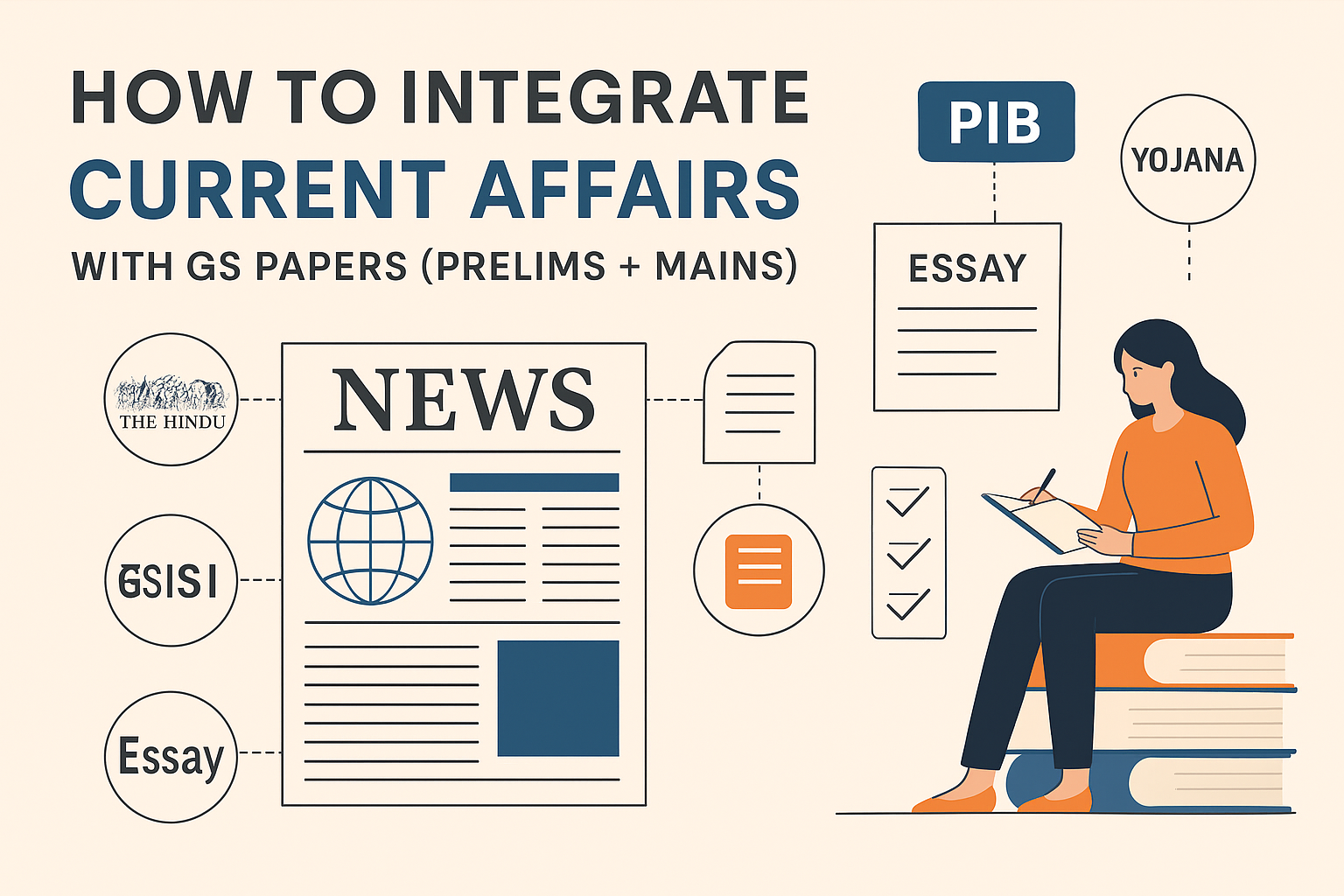How to Integrate Current Affairs with GS Papers (Prelims + Mains)
The Civil Services Examination conducted by the UPSC demands not only a strong understanding of core concepts but also the ability to correlate them with dynamic developments in the country and the world. Aspirants who master the art of integrating current affairs with their General Studies (GS) answers and essays hold a significant edge over others.
Current affairs are not a separate subject but a flowing thread that links with every GS paper — be it Polity, Economy, Environment, or Ethics. When answers are backed with current examples, reports, government initiatives, and real-life case studies, they become more relevant, insightful, and score-worthy.
In this blog, we will guide you on how to effectively integrate current affairs with GS Prelims and Mains answers using reliable sources like The Hindu, PIB, Yojana, Kurukshetra, Rajya Sabha TV, and others.
Join WhatsApp community for Free Notifications, Updates, Study Material, Mock Tests, Internship Updates, and Current Affairs - CLICK HERE TO JOIN
Why Current Affairs Are Crucial for GS Papers
GS Prelims
The Preliminary Examination has become increasingly dynamic. A good number of questions, especially in Polity, Economy, Environment, and International Relations, are directly or indirectly based on recent developments. Understanding concepts through current examples makes retention easier and helps in solving tricky factual questions.
GS Mains
In the Mains Examination, the focus is on analytical writing. UPSC expects you to present well-structured arguments backed by examples. That’s where current affairs play a major role:
- To substantiate arguments with real-time data and events
- To add weight to introductions and conclusions
- To present multiple perspectives on an issue
- To showcase awareness of government schemes and policies
To Enroll in FIRST IAS INSTITUTE - Click Here
Sources You Must Follow Religiously
The Hindu
- Focus on editorials, Op-Ed pages, and national/international news
- Look for issues, not events. For example, rather than memorizing a cabinet reshuffle, understand the larger issue of political accountability.
- Note down constitutional references, legal verdicts, and social issues discussed
PIB (Press Information Bureau)
- Track press releases of various ministries
- Ideal source for flagship schemes, data, and quotes from ministers
- Helps in understanding government perspectives and official language
Yojana and Kurukshetra
- Rich content for social issues, development programs, rural and urban governance
- Written by domain experts and bureaucrats, thus provides credibility
- Use these magazines for essay fodder, ethics case studies, and GS Paper II & III
Rajya Sabha TV / Sansad TV (Discussions like "Big Picture")
- Great for understanding multiple viewpoints
- Helps in articulation of arguments for Mains
- Useful phrases and analytical structure for essays
Government Reports and Economic Survey
- NITI Aayog documents, Economic Survey, and Budget help support your answers with data
- Use keywords and diagrams from these reports in GS answers
Join WhatsApp community for Free Notifications, Updates, Study Material, Mock Tests, Internship Updates, and Current Affairs - CLICK HERE TO JOIN
How to Integrate Current Affairs with GS Prelims
Link Dynamic Content with Static Concepts
- Polity: Connect Supreme Court verdicts with constitutional provisions
- Economy: Understand RBI policies in light of inflation trends or economic indicators
- Geography & Environment: Track cyclones, biodiversity reports, UN conventions
- Science & Tech: Focus on applications and implications of emerging technologies
Practice Reverse Engineering
- Take any current event and ask: “What GS topic does this relate to?”
- For example, the ban on certain pesticides relates to: Environmental Pollution + Agriculture + International Conventions
Develop an Issue-Based Understanding
Instead of memorizing events, understand the background and context:
- Example: Rather than just noting the passing of the Data Protection Bill, understand the fundamental rights involved, SC judgments on privacy, and global data protection frameworks like GDPR.
How to Integrate Current Affairs with GS Mains Answers
GS Paper I – Indian Society, History, Geography
- Use census data, NFHS reports, and NCRB data to support societal trends
- Quote Yojana articles on social issues like women empowerment, caste dynamics, or urbanization
- Use recent natural disasters (like Joshimath or cyclone Biparjoy) to frame geography-based answers
GS Paper II – Polity, Governance, International Relations
- Refer to landmark SC judgments, committee recommendations, or Parliamentary debates
- Link current government schemes and their real-time impact (like Jal Jeevan Mission, PM SHRI Schools)
- For international relations, track India’s diplomatic engagements and use examples from The Hindu or PIB
GS Paper III – Economy, Environment, Science & Security
- Use data from Budget, Economic Survey, or RBI reports to strengthen economic analysis
- Mention NGT rulings, climate pacts, and sustainable development initiatives in environment-related questions
- Refer to DRDO achievements, new defense policies, and cyber security cases for internal security
GS Paper IV – Ethics, Integrity, and Aptitude
- Use real-life stories of civil servants in news for case studies
- Quote recent administrative reforms or behavioral insights used in policy-making
- Track speeches of leaders and bureaucrats that reflect ethical values (from PIB or Yojana)
To Enroll in FIRST IAS INSTITUTE - Click Here
Tips to Enrich Essay Writing with Current Affairs
Choose Topics You Can Link with Multiple Issues
For example, a topic like “Technology as an enabler in governance” can include:
- Digital India initiatives
- Aadhaar linkage debates
- Use of AI in healthcare and agriculture
- Concerns over digital divide and data privacy
Use Current Affairs in All Essay Sections
- Introduction: Begin with a relevant quote or current event
- Body: Present various dimensions using recent developments
- Conclusion: Suggest way forward using government policy goals, NITI Aayog vision, or a new initiative
Examples of Real Integration
- Quoting the National Family Health Survey for essays on health and gender
- Referring to Swachh Bharat Abhiyan with statistical improvements in sanitation
- Using India’s G20 Presidency to reflect on multilateralism and leadership
Note-Making Strategy to Link Static and Dynamic Content
Maintain Subject-Wise Current Affairs Notes
Create a separate notebook or digital file for each GS Paper:
- Under each topic, add current events, examples, and quotes
- Regularly update these with newspaper clippings, PIB releases, and monthly magazines
Use Digital Tools
- Use apps like Evernote, Notion, or OneNote to tag articles and reports by topics
- Save editorials and highlight key lines
- Create flashcards with current examples for revision
Join WhatsApp community for Free Notifications, Updates, Study Material, Mock Tests, Internship Updates, and Current Affairs - CLICK HERE TO JOIN
Practice Answer Writing with Current Examples
Join a Test Series
Joining a structured test series like the one offered by First IAS Institute can help you practice real-time application of current affairs. It helps simulate the actual UPSC scenario and receive expert feedback on how effectively you've used current events in answers.
Peer Review and Daily Writing
- Write at least one GS answer daily using a current event as a base
- Exchange answers with peers for feedback
- Check model answers from newspapers or reliable platforms to improve structure
Common Mistakes to Avoid
- Dumping facts: Don’t overload your answer with data. Use selectively and contextually.
- Outdated examples: Always ensure your example is recent and relevant.
- Lack of linkages: Simply mentioning a scheme without linking it to the question theme weakens the answer.
- Copy-pasting headlines: Reframe news in analytical language rather than journalistic style.
To Enroll in FIRST IAS INSTITUTE - Click Here
Final Words: Develop an Analytical Mindset
Integrating current affairs with GS answers is not a one-time activity. It requires a mindset shift. Begin looking at news as part of the larger policy-making and governance framework. Always ask:
- What issue is this news highlighting?
- What are the causes and implications?
- How does this connect with my GS syllabus?
Once this habit sets in, your answers will naturally reflect depth, maturity, and awareness — the very things UPSC values.
Remember, it’s not about how many newspapers you read, but how well you read and integrate them.


 firstiasofficial@gmail.com
firstiasofficial@gmail.com
Leave a Comment